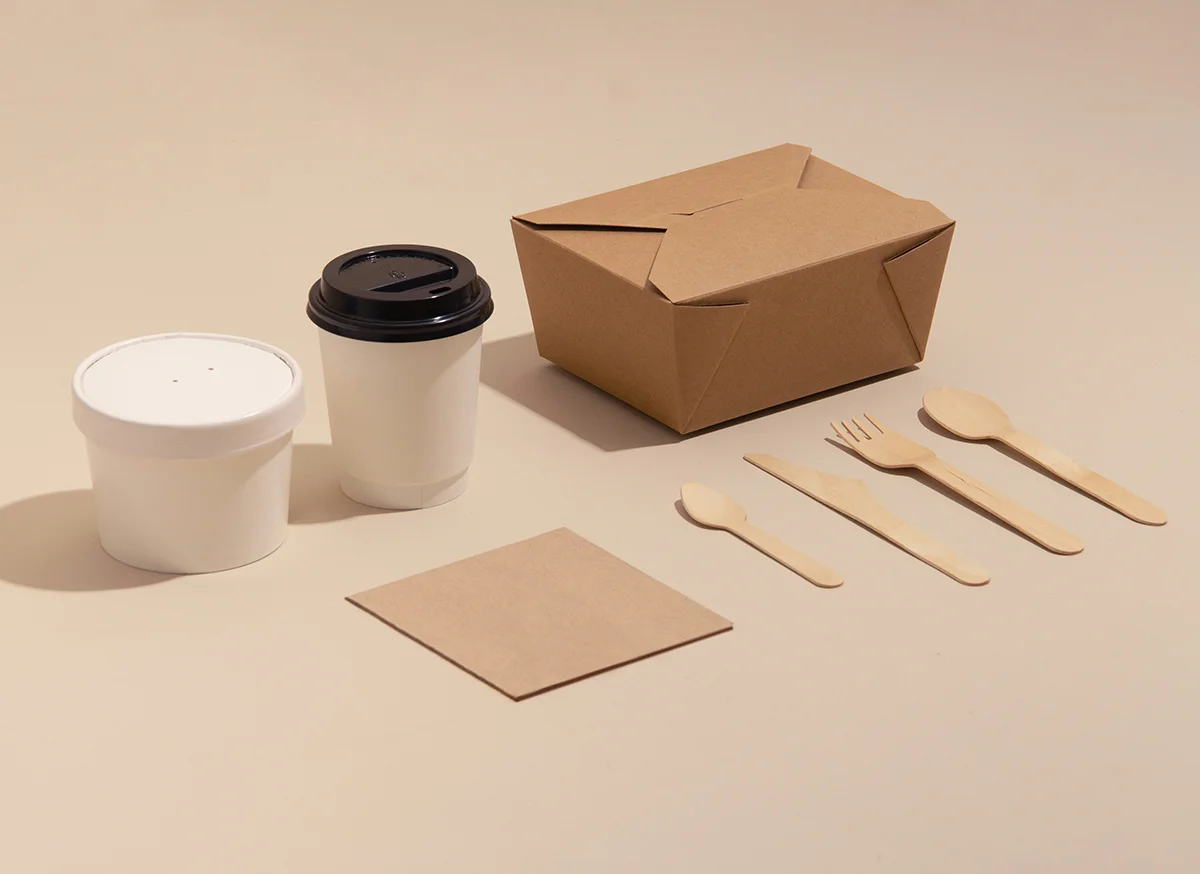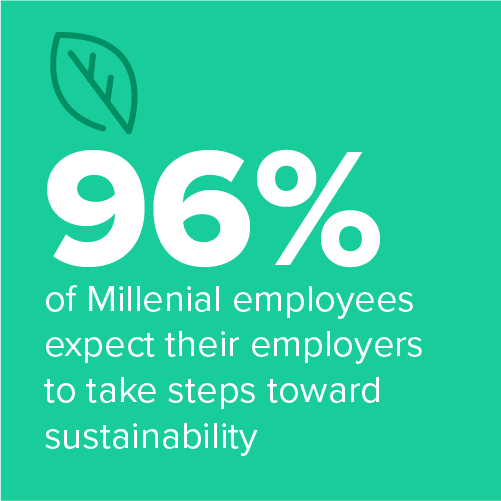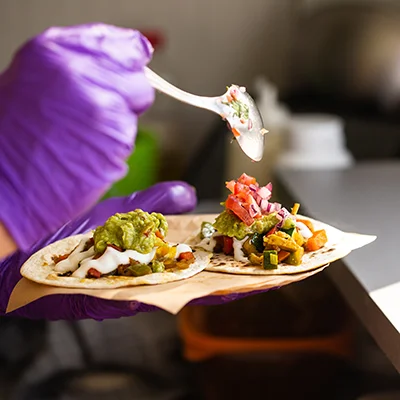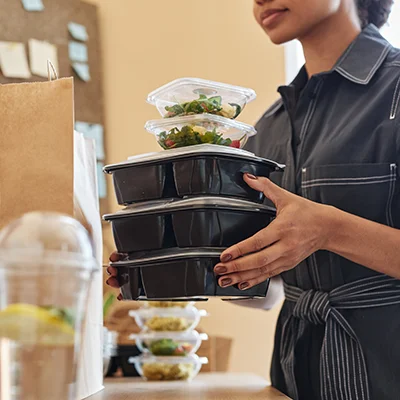
With growing climate change concerns, we’re seeing a rising trend of corporations adopting more sustainable practices to reduce their environmental impact. They’re shifting to eco-friendly products and powering their operations with renewable energy…
Yet they may not extend these sustainability efforts to their workplace food program, which is the true difference maker.
Before you know it, those takeout containers, plastic bottles, and single-use coffee cups (along with their plastic lids) add up to create tons of waste that eventually end up in the landfill.
With the average office worker using 500 coffee cups and throwing away 156 plastic bottles a year, imagine how much waste an entire office will generate. And that’s not counting the wrappers and the plastic containers. The EPA even estimates that food packaging materials make up almost 50% of municipal solid waste in the USA.
So if your office is going to reduce its overall environmental impact, you need to adopt sustainable workplace dining practices. Adopting sustainable food packaging and minimizing packaging waste are a great place to start.

Sustainable packaging refers to packaging solutions that are designed to minimize environmental impact. It mainly involves the use of materials that meet certain sustainability metrics, such as compostable, biodegradable, recyclable, or recycled materials.
For instance, you may ditch cling wraps and clear plastic boxes in favor of paper bags or recycled paperboard boxes to serve sandwiches.
The goal of sustainable packaging is to reduce waste and lower the impact on natural resources, which means optimizing designs to reduce the amount of material used.
Paper may be the first thing that comes to mind when you think of sustainable food packaging. But paper leaks and breaks apart. So unless it’s lined with another layer of plastic, it’s not the best option for all types of food.
The good news? There are a lot more options beyond paper. Here are some of the most common types of sustainable food packaging.
Using recyclable and reusable materials extends the packaging life cycle, keeping them out of landfills and reducing waste. You can reuse and recycle materials like glass, aluminum, and tin. This makes them perfect for packing beverages and water- or oil-based foods.
Meanwhile, paper and cardboard are also recyclable and ideal for dry food packaging. You could even use them for low-moisture foods like pastries and sandwiches.

Eco-friendly packaging options made from plant-based materials are biodegradable and compostable. These materials decompose into the earth without leaving toxic residue, minimizing environmental impact.
Cornstarch packaging is a popular eco-friendly alternative to Styrofoam (the worst offender that never decomposes), suitable for packing foods like curries, noodles, and salads. Mushroom packaging is another excellent alternative that’s fully biodegradable and compostable.
You can also find sustainable food packaging solutions made of recycled material. This is great for conserving natural resources and preventing waste from ending up in landfills. Recycled paper and cardboard are other notable choices for dry food packaging and meals with low moisture content. Think: sandwiches, wraps, and baked goods.
Recycled plastic also meets several sustainability metrics, as it gives second life to plastic that’s already in circulation and extends its life cycle.
But keep in mind that plastic is susceptible to contamination. So unless you’re using recycled plastic that went through a rigorous decontamination process and complies with FDA regulations, it’s not always the safest option for food packaging.
Before you invest too heavily in sustainable food packaging options, you may want to know why this matters. Why should you go through the trouble of choosing sustainable alternatives? Let’s break down the key benefits.
Sustainable food packaging means less packaging waste because you’re using materials that are reusable and recyclable, which mitigates environmental pollution. With fewer resources going into this type of packaging, you can quickly lower your carbon footprint as an organization.
And the waste that you do create is compostable or biodegradable, so it doesn’t harm the Earth. On top of this, biodegradable packaging requires less energy to produce, resulting in lower greenhouse gas emissions.
Companies may also ditch the packaging altogether and opt for dining solutions where employees can enjoy freshly cooked meals on-site and reduce their environmental impact. This also saves you the trouble of searching for restaurants that use sustainable materials for their takeaway boxes.

Unsustainable food packaging poses a serious health risk, with plastic being a common culprit, along with silicone and coatings on metal cans. These materials can absorb harmful chemicals, which then transfer to food.
In fact, over 3,600 chemicals that have been approved for food contact in packaging were found in humans. Among these were compounds like phthalates, PFAS, and bisphenol, which are linked to serious health issues. So by making the switch to sustainable alternatives, you can prioritize the health and safety of your employees.
Glass, for instance, has virtually no detected chemicals. This makes it one of the safest packaging materials for food.
Combined with a healthy cafeteria menu, sustainable food packaging choices show your employees that you truly care about their well-being.
On that note, when employees can clearly see that you care about them, they’re more likely to be satisfied. In fact, 84% of employees who believe their employers care about them report high job satisfaction.
Making more sustainable food packaging choices also helps you align with employees’ values. According to PwC, employees care about how their company is responding to climate change. They’re also extremely focused on the company’s policy regarding carbon emissions as well as their recycling and reuse practices.
So it’s no wonder that 96% of Millennial employees expect their employers to take necessary steps toward sustainability.
Additionally, 84% of employees will even be more loyal to a company if it gives them the chance to positively contribute to social and environmental causes. And sustainable food packaging makes it easier for employees to reduce their individual carbon footprint.
All these numbers prove that employees enjoy working for companies that make sustainability a priority. And higher job satisfaction means they’re less likely to leave the company, leading to higher employee retention.
Sustainability in the workplace goes beyond your choice of food packaging. It’s about making intentional choices to cut waste and minimize your overall environmental impact. Here are some practical tips to adopt sustainable workplace dining practices.
Fooda offers corporate dining solutions that support your sustainability goals. From on-site dining setups to individual packaged meals, you can find flexible options designed to meet your unique business needs.

Services like Orange by Fooda let you bring in guest restaurants to cook on-site and serve fresh and tasty meals, minus the individual packaging. This drastically reduces packaging waste and ensures better workplace sustainability.
Plus, employees get to choose from a rotating lineup of cuisines, which fights menu fatigue. So they’re less likely to create plate waste just because they’re tired of having the same thing over and over again. Not to mention that they get to enjoy tasty and authentic meals cooked by the best local chefs. And when the food’s good, you’re less likely to see leftovers.
Fooda’s technology also makes it easier to plan your menu based on employee demand. You can track order history and attendance trends to bring in the right restaurants at the right time.

When catering or on-site cooking isn’t an option, Fooda’s Office Lunch Delivery service streamlines individual meal orders. Your employees place their individual orders from a designated restaurant, which takes the guesswork out of meal planning. Food is prepared on a pre-order basis, resulting in less food waste.
Once the food is ready, a dedicated Fooda staff member delivers the entire order in bulk straight to your office. This means fewer trips and lower carbon emissions.
Ready to make more sustainable dining choices at work? Talk to Fooda today and find a solution that works for you.
Tracking packaging waste, food waste, and delivery frequency gives you a baseline. A corporate dining partner can help you analyze ordering patterns, identify waste sources, and implement solutions that show measurable improvement over time.
Pre-order systems tied to actual attendance eliminate overproduction and excess packaging. Employees order only when they're in office, and meals are prepared based on confirmed demand rather than estimates.
Rotating restaurant lineups and diverse menu options actually reduce waste while meeting varied preferences. When employees consistently find food they enjoy, plate waste drops significantly compared to limited menus that lead to uneaten meals.